ISSN ONLINE(2319-8753)PRINT(2347-6710)
ISSN ONLINE(2319-8753)PRINT(2347-6710)
K.Vidhya1, A.Bazila Banu2
|
| Related article at Pubmed, Scholar Google |
Visit for more related articles at International Journal of Innovative Research in Science, Engineering and Technology
The project is designed to develop a density based dynamic traffic signal system. The signal timing changes automatically on sensing the traffic density at the junction. Traffic congestion is a severe problem in many major cities across the world and it has become a nightmare for the commuters in these cities. Conventional traffic light system is based on fixed time concept allotted to each side of the junction which cannot be varied as per varying traffic density [1]. Junction timings allotted are fixed. Sometimes higher traffic density at one side of the junction demands longer green time as compared to standard allotted time. The image captured in the traffic signal is processed and converted into grayscale image then its threshold is calculated based on which the contour has been drawn in order to calculate the number of vehicles present in the image. After calculating the number of vehicles we will came to know in which side the density is high based on which signals will be allotted for a particular side. Raspberry pi is used as a microcontroller which provides the signal timing based on the traffic density.
Keywords |
| Raspberry pi, Image Processing, Vehicles Counting, Adaptive traffic control system |
INTRODUCTION |
| In modern life we have to face with many problems one of which is traffic congestion becoming more serious day after day. It is said that the high volume of vehicles, the inadequate infrastructure and the irrational distribution of the development are main reasons for increasing traffic jam. The major cause leading to traffic congestion is the high number of vehicle which was caused by the population and the development of economy. Traffic congestion is a condition on road networks that occurs as use increases, and is characterized by slower speeds, longer trip times, and increased vehicular queuing. The most common example is the physical use of roads by vehicles. When traffic demand is great enough that the interaction between vehicles slows the speed of the traffic stream, these results in some congestion .As demand approaches the capacity of a road (or of the intersections along the road), extreme traffic congestion sets in. When vehicles are fully stopped for periods of time, this is colloquially known as a traffic jam or traffic snarl-up. Traffic congestion can lead to drivers becoming frustrated and engaging in road rage. In order to avoid the congestion in the traffic. In traffic environments, Traffic Sign Recognition (TSR) is used to regulate traffic signs, warn the driver, and command or prohibit certain actions. A fast real-time and robust automatic traffic sign detection and recognition can support and disburden the driver, and thus, significantly increase driving safety and comfort. Generally, traffic signs provide the driver various information for safe and efficient navigation Automatic recognition of traffic signs is, therefore, important for automated intelligent driving vehicle or driver assistance systems. However, identification of traffic signs with respect to various natural background viewing conditions still remains challenging tasks. Real time automatic vision based traffic light control has been recently the interest of many researchers, due to the frequent traffic jams at major junctions and its resulting wastage of time. Instead of depending on information generated by costly sensors, economic situation calls for using available video cameras in an efficient way for effective traffic congestion estimation. Thus, given a video sequence, the task of vision based traffic light control list: 1) analyze image sequences; 2) estimate traffic congestion and 3) predict the next traffic light interval. Researchers may focus on one or more of these tasks, and they may also choose different measures for traffic structure or add measures. For more comprehensive review on vision based traffic light control |
| Due to the massive growth in urbanization and traffic congestion, intelligent vision based traffic light controller is needed to reduce the traffic delay and travel time especially in developing countries as the current automatic time based control is not realistic while sensorbased traffic light controller is not reliable in developing countries. |
| Traffic congestion is now considered to be one of the biggest problems in the urban environments. Traffic problems will be also much more widely increasing as an expected result of the growing number of transportation means and current low-quality infrastructure of the roads. In addition, many studies and statistics were generated in developing countries that proved that most of the road accidents are because of the very narrow roads and because of the destructive increase in the transportation means. This idea of controlling the traffic light efficiently in real time has attracted many researchers to work in this field with the goal of creating automatic tool that can estimate the traffic congestion and based on this Variable, the traffic sign time interval is forecasted. |
MOTIVATION |
| The traffic lights that are in widespread use today do not do much intricate reasoning when deciding when to change the lights for the various road users waiting in different lanes. |
| How long the signal stays green in one lane and red in another is most often determined by simple timing that is calculated when the crossing is designed. Even though today’s methods are robust and work well when the traffic load is distributed evenly across the lanes in the intersection, the systems are very inefficient because they are unable to handle various simple situations that arise throughout the day. Unnecessary waiting time in the signal can be avoided by determining in which side the green signal should be large during the traffic. In Case the structure of the traffic [2]. |
PROBLEM DEFINITION AND LIMITATION |
| Researchers now are so much interested in automatic real-time traffic congestion estimation tool as it is the most significant factor on which intelligent transportation systems are based. Some of the researchers have focused in their work on traffic flow estimation. It is measured as the rate at which vehicles pass a fixed point (e.g. vehicles per minute). They used spot sensors such as loop detectors and pneumatic sensors to quantify the traffic flow However; the sensors are very expensive and need a lot of maintenance especially in developing countries because of the road ground de-formations. In addition, metal barriers near the road might prevent effective detection using radar sensors. It is also found that traffic congestion also occurred while using the electronic sensors for controlling the traffic. In contrast, video based systems are much better compared to all other techniques as they provide more traffic information and they are much more scalable with the progress in image progressing techniques. This is the main reason for the motivation to develop vision based tool for traffic light control in this work. In recent years, vision based traffic light control, which is based on video processing for traffic flow or traffic density estimation, has attracted the attention of many researchers. The value of traffic density measures only the ratio between the density of the vehicles and the total density of the road. So based on this measure, the traffic control system will compare between different roads in the intersection to take the decision for the traffic light and the time interval given. However, most of the previous vision based monitoring systems suffered from lack of robustness on dealing with continuously changing environment such as lighting conditions, weather conditions and unattended vehicles. All these mentioned factors considerably affect the traffic density estimation. Changes in lightening conditions and weather conditions have been tackled in many of the previous approaches and they are going to be considered also in our proposed approach, but the problem that has never been addressed before and has a significant effect on the traffic pace is the stationary vehicles, specially the unattended ones. The problem with the traffic density measurement is that the traffic density of a road with stationary or unattended vehicles is the same as the traffic density of a road with no stationary vehicles. Traffic flow counts the number of vehicles that passes through the frame during a certain time interval. However, it may give an empty road a higher priority than a congested road, because fewer vehicles are passing though the given point in that empty road. Therefore, we will concentrate on the detection of the delayed and unattended vehicles in the proposed approach for computing more informative metric about the traffic congestion in order to have more effective way of traffic. This metric is very similar to the traffic density, but with taking the traffic flow into consideration. So it can be considered as a combination of both traffic density and traffic flow. |
ARCHITECHTURE FOR THE CONTROL SYSTEM |
| In this architecture camera is placed on the top of the signal to get the clear view of traffic on the particular side of the signal so that it will capture the image and analyze the traffic in that particular side and get the count of the number of vehicle. With this count the density of that particular side will be determined and corresponding signal will be provided. Fig 1 |
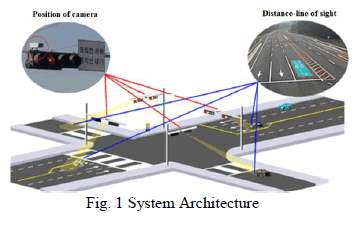 |
DENSITY MEASUREMENT |
| A. Source Image |
| In this system the source image is the RGB image which can be given by the users for getting the contour image and the vehicle count in output screen. The following code can be used to auto size of the output screen .Fig 2 |
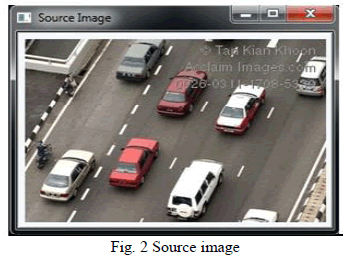 |
| B.Grayscale Image |
| The grayscale image can be used to display the objects in the format of black and white. In this system the output will be display the grayscale image after getting the source image only, because source image only converted into the grayscale image. |
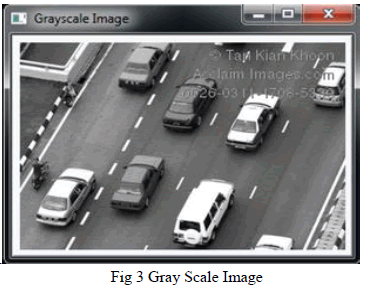 |
| C. Threshold Image |
| The threshold image brightness or contrast of the grayscale image. In this system we can convert the grayscale image to threshold image. |
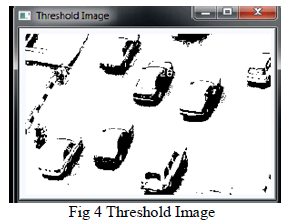 |
| D. Canny image |
| Canny image is the image one of the edge detector that can be used to outline the edges of the objects. It can be help full for find out the objects.Here we have convet the threshold image to canny image |
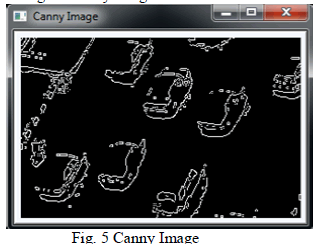 |
| E .Erode Image |
| The Erode image also like the canny image it can be used find the edges with the darked lines.In our system the edges of the vehicles are detect with the darked lines Before converting the canny image to Erode image, the canny image will be destroied. |
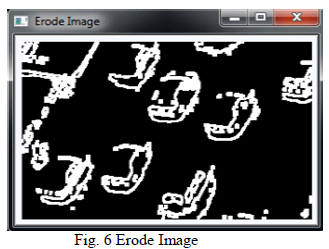 |
| Before showing the vehicles count and output screen the Erode Image converted into the contour image. This image is the final step to find the vehicled counts and output screen. |
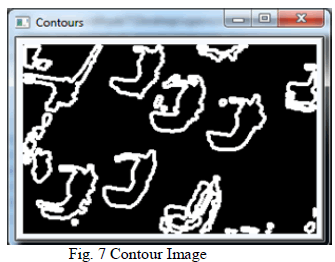 |
| G. Output screen |
| The two types of output screens are displyed in this system. They are, |
| 1) First output screen disply the output image. In this image will display the original RGB Image and in this screen the vehicles are boxed for the find the count. |
| 2) Another output screen is the command prompt. In this command prompt will be open when the user run this system, in final stage after getting the output image the command promt will display the vehicle counts. |
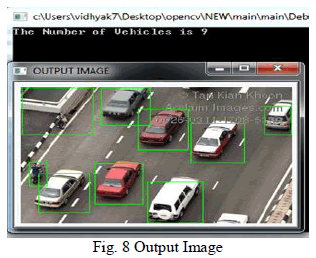 |
| H. Digital Image Processing |
| Digital image processing is the use of computer algorithms to perform image processing on digital images. As a subfield of digital signal processing, digital image processing has many advantages over analog image processing; it allows a much wider range of algorithms to be applied to the input data, and can avoid problems such as the build-up of noise and signal distortion during processing. The different levels at which one may want to interact with the system |
| 1) User interface: Running the GUI, Creation of batch jobs for applications using mat lab batch, Batch management, batch execution, including use of MATLAB scripts to run batch jobs on multiple datasets with very little user interaction |
| 2) Application development: Requirements on code structure of application |
| 3) Introduction: Internal representation of batch configurations, Introduction to writing batch configuration scripts, Integration of an application into configuration management and GUI |
| 4) Implementation: Classes used, Methods, Details about job management, runtime etc. |
| 5) Disadvantage: Interpreted programming language, slower than C++ and V. FORTRAN. This tool cannot be used for real time application it will give only the simulation results.Matlab software is not free of cost. Our application requires the real time application software so opencv is used as the image processing technique. |
CONCLUSIONS |
| We conclude the Density measurement by using opencv tool as software for image processing by just displaying the various conversion of image in the screen and finally surrounding the box on the vehicle in the given image, the number of vehicle is calculated. |
| We can calculate the density of the vehicle by using mat lab tool by comparing the four side of the image which is given as a input. we can simulate the result of the four given input image but this cannot be used in real time applications as it is very slow and the software is not free of cost like opencv to overcome this disadvantage of mat lab, opencv software is used which is very easy to install and is open source software and can be used in real time application in a quick manner. In this paper we have shown the density measurement in the signal by using opencv in the System. |
REMAINING WORK |
| In future work Raspberry pi microcontroller can be used which will directly integrate the opencv software there is no need to install the opencv in the system. With the help of raspberry pi we can provide the view of the traffic to the traffic controller room so that the green signal will be provided for the longer time in the required area during the signal in order to avoid the unnecessary waiting time during the signal. |
ACKNOWLEDGEMENT |
| We would like to thank our head of the department Mr.S.Raj Pandian and my guide Mrs.A.Bazila Banu for motivating us in doing such kind of real time projects and thanks to all my friend kavitha thangalakshmi and the web sources. |
References |
|